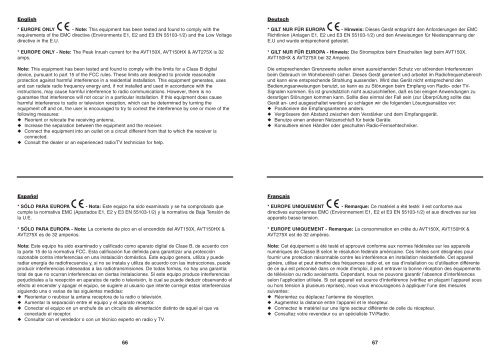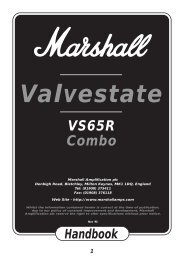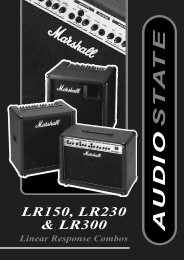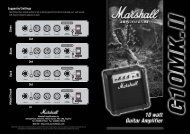AVT150X, AVT150HX & AVT275X - Marshall
AVT150X, AVT150HX & AVT275X - Marshall
AVT150X, AVT150HX & AVT275X - Marshall
You also want an ePaper? Increase the reach of your titles
YUMPU automatically turns print PDFs into web optimized ePapers that Google loves.
English<br />
* EUROPE ONLY - Note: This equipment has been tested and found to comply with the<br />
requirements of the EMC directive (Environments E1, E2 and E3 EN 55103-1/2) and the Low Voltage<br />
directive in the E.U.<br />
* EUROPE ONLY - Note: The Peak Inrush current for the <strong>AVT150X</strong>, <strong>AVT150HX</strong> & <strong>AVT275X</strong> is 32<br />
amps.<br />
Note: This equipment has been tested and found to comply with the limits for a Class B digital<br />
device, pursuant to part 15 of the FCC rules. These limits are designed to provide reasonable<br />
protection against harmful interference in a residential installation. This equipment generates, uses<br />
and can radiate radio frequency energy and, if not installed and used in accordance with the<br />
instructions, may cause harmful interference to radio communications. However, there is no<br />
guarantee that interference will not occur in a particular installation. If this equipment does cause<br />
harmful interference to radio or television reception, which can be determined by turning the<br />
equipment off and on, the user is encouraged to try to correct the interference by one or more of the<br />
following measures:<br />
◆ Reorient or relocate the receiving antenna.<br />
◆ Increase the separation between the equipment and the receiver.<br />
◆ Connect the equipment into an outlet on a circuit different from that to which the receiver is<br />
connected.<br />
◆ Consult the dealer or an experienced radio/TV technician for help.<br />
Español<br />
* SÓLO PARA EUROPA - Nota: Este equipo ha sido examinado y se ha comprobado que<br />
cumple la normativa EMC (Apartados E1, E2 y E3 EN 55103-1/2) y la normativa de Baja Tensión de<br />
la U.E.<br />
* SÓLO PARA EUROPA - Nota: La corriente de pico en el encendido del <strong>AVT150X</strong>, <strong>AVT150HX</strong> &<br />
<strong>AVT275X</strong> es de 32 amperios.<br />
Nota: Este equipo ha sido examinado y calificado como aparato digital de Clase B, de acuerdo con<br />
la parte 15 de la normativa FCC. Esta calificación fue definida para garantizar una protección<br />
razonable contra interferencias en una instalación doméstica. Este equipo genera, utiliza y puede<br />
radiar energía de radiofrecuencia y, si no se instala y utiliza de acuerdo con las instrucciones, puede<br />
producir interferencias indeseadas a las radiotransmisiones. De todas formas, no hay una garantía<br />
total de que no ocurran interferencias en ciertas instalaciones. Si este equipo produce interferencias<br />
perjudiciales a la recepción en aparatos de radio o televisión, lo cual se puede deducir observando el<br />
efecto al encender y apagar el equipo, se sugiere al usuario que intente corregir estas interferencias<br />
siguiendo una o varias de las siguientes medidas:<br />
◆ Reorientar o reubicar la antena receptora de la radio o televisión.<br />
◆ Aumentar la separación entre el equipo y el aparato receptor.<br />
◆ Conectar el equipo en un enchufe de un circuito de alimentación distinto de aquel al que va<br />
conectado el receptor.<br />
◆ Consultar con el vendedor o con un técnico experto en radio y TV.<br />
Deutsch<br />
* GILT NUR FÜR EUROPA - Hinweis: Dieses Gerät entspricht den Anforderungen der EMC<br />
Richtlinien (Anlagen E1, E2 und E3 EN 55103-1/2) und den Anweisungen für Niederspannung der<br />
E.U und wurde entsprechend getestet.<br />
* GILT NUR FÜR EUROPA - Hinweis: Die Stromspitze beim Einschalten liegt beim <strong>AVT150X</strong>,<br />
<strong>AVT150HX</strong> & <strong>AVT275X</strong> bei 32 Ampere.<br />
Die entsprechenden Grenzwerte stellen einen ausreichenden Schutz vor störenden Interferenzen<br />
beim Gebrauch im Wohnbereich sicher. Dieses Gerät generiert und arbeitet im Radiofrequenzbereich<br />
und kann eine entsprechende Strahlung aussenden. Wird das Gerät nicht entsprechend den<br />
Bedienungsanweisungen benutzt, so kann es zu Störungen beim Empfang von Radio- oder TV-<br />
Signalen kommen. Es ist grundsätzlich nicht auszuschließen, daß es bei einigen Anwendungen zu<br />
derartigen Störungen kommen kann. Sollte dies einmal der Fall sein (zur Überprüfung sollte das<br />
Gerät an- und ausgeschaltet werden) so schlagen wir die folgenden Lösungsansätze vor:<br />
◆ Positioniere die Empfangsantenne anders.<br />
◆ Vergrössere den Abstand zwischen dem Verstärker und dem Empfangsgerät.<br />
◆ Benutze einen anderen Netzanschluß für beide Geräte.<br />
◆ Konsultiere einen Händler oder geschulten Radio-Fernsehtechniker.<br />
Français<br />
* EUROPE UNIQUEMENT - Remarque: Ce matériel a été testé: il est conforme aux<br />
directives européennes EMC (Environnement E1, E2 et E3 EN 55103-1/2) et aux directives sur les<br />
appareils basse tension.<br />
* EUROPE UNIQUEMENT - Remarque: La consommation en crête du <strong>AVT150X</strong>, <strong>AVT150HX</strong> &<br />
<strong>AVT275X</strong> est de 32 ampères.<br />
Note: Cet équipement a été testé et approuvé conforme aux normes fédérales sur les appareils<br />
numériques de Classe B selon le résolution fédérale américaine. Ces limites sont désignées pour<br />
fournir une protection raisonnable contre les interférence en installation résidentielle. Cet appareil<br />
génère, utilise et peut émettre des fréquences radio et, en cas d’installation ou d’utilisation différente<br />
de ce qui est préconisé dans ce mode d’emploi, il peut entraver la bonne réception des équipements<br />
de télévision ou radio avoisinants. Cependant, nous ne pouvons garantir l’absence d’interférences<br />
selon l’application utilisée. Si cet appareil est source d’interférence (vérifiez en plaçant l’appareil sous<br />
ou hors tension à plusieurs reprises), nous vous encourageons à appliquer l’une des mesures<br />
suivantes:<br />
◆ Réorientez ou déplacez l’antenne de réception.<br />
◆ Augmentez la distance entre l’appareil et le récepteur.<br />
◆ Connectez le matériel sur une ligne secteur différente de celle du récepteur.<br />
◆ Consultez votre revendeur ou un spécialiste TV/Radio.<br />
66 67









![AVT100X [2.16 MB] - Marshall](https://img.yumpu.com/11365367/1/184x260/avt100x-216-mb-marshall.jpg?quality=85)






